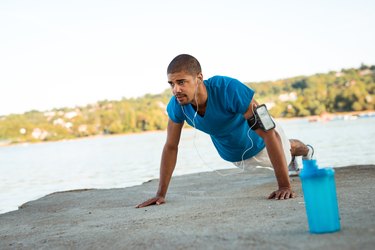
If you want to boost your stamina, burn calories, sculpt your muscles and improve your cardiovascular fitness all in a short amount of time, consider doing high-intensity interval training (HIIT).
HIIT is a method that alternates short bursts of near-maximum effort with slightly longer rest periods — great news when you're short on time and need to maximize your efforts, according to the American Council on Exercise (ACE). Plus, since you can do HIIT with or without equipment, you always have access to a completely portable and convenient way to get fit.
Read more: 7 Tips to Jump-Start Your HIIT Workouts
Why You Should Add Body-Weight HIIT Workouts to Your Routine
Body-weight HIIT workouts are a quick and effective way to knock out your cardio and strength training at the same time. Since you decide the level of exertion, you can customize the intensity based on your fitness level, how your body is feeling that day or what you want to accomplish.
Adding body-weight exercises to a HIIT session allows you to perform strength-training moves without needing any dumbbells, barbells or gym machines. You can also get your work done at a quicker pace, since you're not wasting time swapping out weights. Plus, with body-weight moves, you can choose to target multiple muscle groups at the same time — you can pair squats for your lower body with push-ups for your upper body, for example — or you can just as easily isolate one or two smaller muscles groups, say, the triceps with dips.
But probably one of the best reasons to add body-weight exercises to your HIIT sessions? You will never get bored. With countless ways to build a routine and hundreds of combinations to try, working out can be something you finally look forward to at the end of the day.
How to Get Started
Before you jump into a body-weight HIIT workout, there are some basic guidelines to know about that apply to all fitness levels. These tips will also help you stay motivated as your HIIT sessions take off.
1. Make HIIT Work for You
If an exercise feels too difficult, there's always a way to modify a movement to match your fitness level, Riley O'Donnell, certified trainer at Fhitting Room in New York City, tells LIVESTRONG.com. If you're not sure how to do this, ask a trainer at your gym or search online for examples of exercise modifications.
One easy way to modify for beginners (or if you're dealing with a previous injury) is to take the jumping out. For example: Box jumps become step-ups and squat jumps become squats.
Even with modifications, make sure you're always feeling challenged during the work periods of your HIIT sessions. You should be exercising hard enough that you feel like you really need your rest periods.
2. Prepare Your Body
What you do before a HIIT is so important. "What you do before and after the class is so important," stresses O'Donnell. "Learn foam rolling techniques and active stretching to prime your body for exercise and to help you recover," she adds. Spend at least five minutes doing dynamic and active stretching, plus some gentle cardio movements like jogging in place to get your muscles warm.
3. Ease Into Things
"Introduce HIIT gradually," says O'Donnell. Slowly getting into a HIIT routine is the best way to avoid injury and burnout. "Training at this level is intense, so it's a good idea to start with one to two times a week of HIIT training. As you become more comfortable and confident, you can add on more," she adds.
Staggering your HIIT workouts throughout the week by allowing at least one to two days between sessions will help your body recover and recharge, she says.
Read more: How to Do a HIIT Workout at Home
4. Don't Cut Rest Periods Short
As tempting as it may be to power through the rest period — especially if you're really crushing it — resist the urge to skimp on your rest period, says O'Donnell. HIIT only works if you follow the work to recovery intervals. Otherwise, you're just doing a continuous high-intensity workout, which won't last for too long.
5. Wind Down Before You Head Out
Training at a high intensity requires adequate time for recovery after the workout is complete, according to ACE. Tack on at least 10 minutes to the end of your session to bring your heart rate back to normal and perform some static stretches. This is also a great time to do a few yoga poses to help restore balance to your body with some yoga. Consider trying pigeon pose to open up through your hips.
Get Moving With This Body-Weight HIIT Workout
This body-weight HIIT plan from O'Donnell will test your cardio fitness and challenge your muscular strength and endurance — all in less than 30 minutes. For this particular program, O'Donnell says to run each exercise as its own Tabata circuit, which is a specific training style that follows a set interval ratio.
- You'll do four exercises: speed skaters, squat thrusts, plank ups and hollow hold flutter kicks.
- Complete eight rounds total of each exercises before continuing to the next move.
- Perform each exercise for 20 seconds of max effort, followed by a 10-second rest at the end. Use a stopwatch or the timer on your watch or phone to keep track of the intervals.
- Rest one to two minutes between each move.
Move 1: Speed Skater
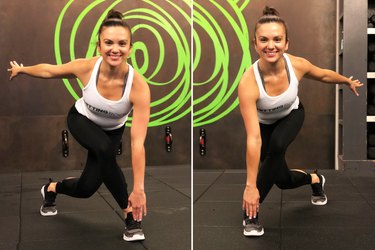
- Start in a curtsy stance with the majority of your weight on the front leg.
- Launch off of the front foot and take a wide, low, lateral leap onto the other foot.
- Land in a low curtsy stance on the other leg; jump back to start.
- Perform 20 seconds of speed skaters.
- Rest for 10 seconds.
- Repeat this work/rest set for eight times total.
Move 2: Squat Thrust
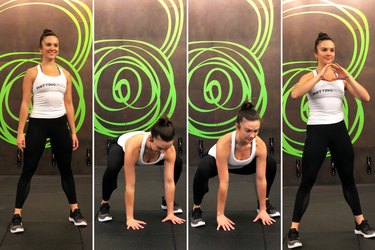
- Start with your feet slightly wider than hip-width distance.
- Lower your hips and bring your hands flat to the floor.
- Jump into a plank position while keeping your core braced.
- Jump your feet outside of your hands and stand up.
- Repeat for 20 seconds.
- Rest for 10 seconds.
- Repeat this work/rest set 8 times total.
Move 3: Plank-Up
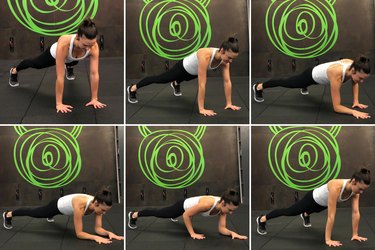
- Begin in high plank position, with your feet hip-width apart.
- Without moving your hips, lower to your right forearm and then your left. This is the forearm plank.
- Place your right hand underneath your right shoulder.
- Push into the floor and extend your right arm as your left hand meets it in high plank.
- Repeat, leading with the left arm.
- Continue to alternate for 20 seconds.
- Rest for 10 seconds.
- Repeat this work/rest set for 8 times total.
Move 4: Hollow Hold Flutter Kick
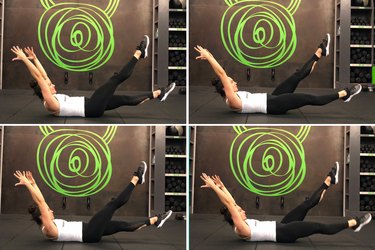
- Begin in the hollow hold position: Hands are reaching back, shoulders and feet are off the floor and core is engaged.
- Without bending your legs or sacrificing the hollow hold, create small kicks in the legs.
- Kick for 20 seconds.
- Rest for 10 seconds.
- Repeat this work/rest set for 8 times total.
Tip
If this is too challenging, maintain your hollow hold and alternate pulling one knee to the chest.